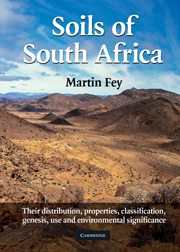Book contents
- Frontmatter
- Contents
- Preface and acknowledgements
- Chapter 1 Introduction to the soil groups and the naming of forms and families
- Chapter 2 The soil groups: distribution, properties, classification, genesis and use
- Chapter 3 Animals in soil environments
- Chapter 4 Profile descriptions and analytical data
- References
- Glossary
- Appendix: Criteria for generating distribution maps for soil groups
- Index
Preface and acknowledgements
Published online by Cambridge University Press: 05 June 2012
- Frontmatter
- Contents
- Preface and acknowledgements
- Chapter 1 Introduction to the soil groups and the naming of forms and families
- Chapter 2 The soil groups: distribution, properties, classification, genesis and use
- Chapter 3 Animals in soil environments
- Chapter 4 Profile descriptions and analytical data
- References
- Glossary
- Appendix: Criteria for generating distribution maps for soil groups
- Index
Summary
Not since C.R. Van der Merwe's Soil Groups and Sub-Groups of South Africa in 1940 has there been a publication that integrates what is known about the distribution, genesis and management of South African soils. There have been some outstanding regional treatments, most notably Soils of the Sugar Belt (Beater, 1957; 1959; 1962) and Soils of the Tugela Basin (Van der Eyk, MacVicar and De Villiers, 1969), both of which were forerunners, via an earlier edition, of the current classification of South African soils (Soil Classification Working Group, 1991). In the latter publication, seventy-three soil forms are identified in terms of defined diagnostic horizons and materials within the soil profile and definitions are supported by explanations of the underlying concept so that users of the classification can infer genesis and behaviour of whole soils from an understanding of the origin, properties and behaviour of the individual horizons and materials that are present. This is sometimes difficult, however, even for those well versed in general soil science.
During the 1970s the Soil and Irrigation Research Institute of the Department of Agricultural Technical Services began the ambitious task of documenting the distribution of soils in South Africa. This was done by mapping land types (soil-landscape-climate associations) at a semi-reconnaissance scale of 1:250 000. Only now is the project in a reasonable state of completion. The maps are accompanied by memoirs that summarise soil distribution patterns in relation to terrain morphological units and provide profile descriptions and laboratory data for modal soil profiles in most land types.
- Type
- Chapter
- Information
- Soils of South Africa , pp. 5 - 7Publisher: Cambridge University PressPrint publication year: 2010

